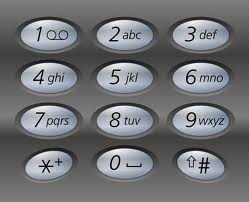The alphabet has 26 letters, whereas the keypad of a mobile phone or GPS device usually has far less keys. The multi-tap technique was one of the first methods used to enter text messages on such devices.
The idea is quite simple: the letters of the alphabet are printed in groups of three or four under each key, beginning on the 2-key (2=ABC, 3=DEF, 4=GHI, 5=JKL, 6=MNO, 7=PQRS, 8=TUV, 9=WXYZ). The technique is then used by repeatedly pressing the same key to cycle through the letters corresponding to that key. In order to enter the letter A, for example, the 2-key must be pressed once. If you want to enter the letter B, the same key must be pressed twice. Pausing for a set period of time will automatically choose the current letter in the cycle, as will pressing a different key. This allows to enter two letters that are mapped on the same key.

The T9 technique is an improvement over the multi-tap technique, originally developed by Tegic Communications. The name of the technique stands for Text on 9 keys, and it is a patented predictive text technology for mobile phones. T9 allows words to be entered by a single keystroke for each letter, as opposed to the multi-tap approach used in conventional phone text entry. For example, the word Banner can be entered with the following sequence of keystrokes: 2 (ABC), 2 (ABC), 6 (MNO), 6 (MNO), 3 (DEF) and 7 (PQRS). The T9 system looks up all possible words corresponding to the sequence of keystrokes in a built-in dictionary. If there are multiple possibilities, the user needs to select the intended word from a list. This usually works a lot faster than entering the individual letters using multi-tap. Two words corresponding to the same sequence of keystrokes with the T9 technique are called mobile synonyms.
Assignment
-
Write a function T9 that takes a single string containing letters only. The function must return the sequence of keystrokes that needs to be entered on a mobile phone keypad supporting T9 in order to enter the given word. The function should handle the given word case-insensitively.
-
Use the function T9 to write a function mobileSynonyms that takes two string arguments representing words that contain letters only. The function must return a Boolean value that indicates whether or not the two given words are mobile synonyms.
Example
>>> T9('Banner')
'226637'
>>> T9('succes')
'782237'
>>> T9('rubber')
'782237'
>>> mobileSynonyms('succes', 'rubber')
True
>>> mobileSynonyms('Monday', 'Friday')
FalseEpilogue
Words that differ in meaning but that are pronounced the same (to varying extent) are homophones1.
Words that differ in meaning but that are spelled alike are homonyms2.
However, no term exists for words that differ in meaning but that are typed the same way on a telephone keypad? The first neologism that came to mind was the term mobile synonym, but probably you can come up with a better term. Creative students already sent me the following proposals:
| term | explanation |
|---|---|
| padonym | analogous to synonym but after the (numeric- /key-) pad of a generic device that follows the standard pattern of arranging numeric keys |
| textonym | analogous to synonym but with a reference to the fact the words are typed as text |
| homonum | sounds like slang (and is likely to be immediately understood due to its similarity to homonym) but actually makes sense (unlike textonym or padonym) |